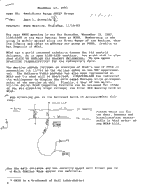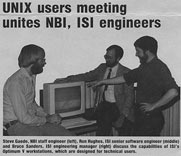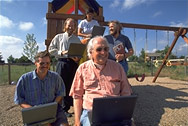Steve Gaede has been FRUUG coordinator since 1984.
In his early years, he created UNIX capacity planning tools.
Today he undertakes a variety of research
and prototyping projects through his company
Lone Eagle Systems Inc.
April 2001 marked the 20th birthday of the Front Range UNIX
Users Group (FRUUG), making it the oldest, still-running local
UNIX user group around.
Our ripe old age-- probably a century in high-tech years--
provides a good excuse for a bit of senile reminiscing
about all we've managed to accomplish in these two decades.
It turns out that we've been surprisingly on top of quite
a few technological developments well before their time;
and embarrassingly wrong about a few, too.
FRUUG's largest concentration of members is in Boulder,
with membership extending along the Front Range of the
Rocky Mountains from Pueblo, Colorado to
Cheyenne, Wyoming. The group meets roughly monthly, scheduling
meetings around the availability of interesting talks and
speakers rather than attempting to meet on a particular
day each month. It currently has close to 300 members,
with around 70 attending any given meeting.
Though it started as a sort of UNIX support
group, it exists today more as a forward-looking computing
technology group, not limited to UNIX operating system topics.
Despite its changing role, one facet
of FRUUG has remained consistent: it has served as a gathering
place and a stable touchstone for computing professionals to
meet and make contacts for more than two decades.
 In 1981, Dick Hackathorn and Rick Patch
founded the Boulder Users' Group (BUG), named without
the adjective describing what it was we used because in those
days nobody dared toy with the sacred trademark of Bell
Laboratories.
The group quickly grew beyond the boundaries of Boulder
and its members voted to re-name it the
Front Range UNIX Users' Group (FRUUG) in early 1982.
Those (including the author) who preferred the more
colloquial sound of BUG still tend to pronounce
FRUUG as if it rhymes with BUG.
(Click for enlargement of antique NCAR
meeting announcement)
In 1981, Dick Hackathorn and Rick Patch
founded the Boulder Users' Group (BUG), named without
the adjective describing what it was we used because in those
days nobody dared toy with the sacred trademark of Bell
Laboratories.
The group quickly grew beyond the boundaries of Boulder
and its members voted to re-name it the
Front Range UNIX Users' Group (FRUUG) in early 1982.
Those (including the author) who preferred the more
colloquial sound of BUG still tend to pronounce
FRUUG as if it rhymes with BUG.
(Click for enlargement of antique NCAR
meeting announcement)
In those days, Boulder was a relative hotbed of UNIX activity,
with research institutions like the University of Colorado,
the National Center of Atmospheric Research (NCAR), and the
National Institute of Science and Technology (NIST);
as well as commercial organizations like
Bell Labs, Cray Labs, NBI, and Storage Technology working with the
UNIX operating system.
One of the first USENIX conferences was held in Boulder in 1980,
pre-dating FRUUG's founding by a year.
Though not officially affiliated with any national group,
FRUUG's meetings for years included reports on current events
from the most recent USENIX conferences.
One of the features that put Boulder on the UNIX map was
the fact that the High Altitude Observatory's UNIX machine (hao)
was a key component in the UUCP networking backbone that
enabled UNIX systems to transfer mail from one to another.
For those who didn't experience those days, UUCP stands for
"UNIX-to-UNIX Copy" and was the basis for a store-and forward
network that was used to copy messages to a remote system
(usually over modem connections)
and then remotely execute a mail program to send them on to
their next hop.
The network was completely ad-hoc. Mail addresses specified
the route to be taken, and the whole thing depended on a lot
of making personal contacts to establish connections.
The early meetings were small enough that they could be
hosted by just about any company that had a few chairs.
They usually included a brief talk, a tour of whatever
facility we visited, and a round table discussion that
provided a forum for people to ask questions like: "can I set up
a UUCP connection to you," or: "do you have a driver
for such and such a disk?" The un-spoken question
often on members' minds was: "what would it be like to work here?"
The days in which meetings toured up and down the Front Range
gave us a good feel for the UNIX activity in the environs.
The community of those using the UNIX operating system was
relatively small and insular, and there was a fair amount
of circulation between companies as interesting projects
came and went.
A memorable fall 1981 meeting was held in an outpost of Interactive Systems
that occupied the old Rocky Mountain National Park headquarters
in downtown Estes Park; that round-table discussion took place
around a roaring fire in a huge stone fireplace with a fall
snow beginning outside.
The early 1980's saw the convergence of three technical
advancements that would form the basis for the desktop
computers that we all use today.
The Motorola 68010 family of microprocessors provided support
for memory mapping, enabling the UNIX operating system to
run on desktop computers with isolated virtual memory for
each process-- one of those basic features that the Wintel
world wouldn't implement until more than a decade later.
Winchester disks became smaller than a filing cabinet and
could fit into desktop workstations.
And bitmapped displays
enabled the graphical user interfaces that brought a new meaning
for the word `mouse' into the vernacular.
 We heard from quite a number of Motorola 68000-based UNIX system
vendors as the desktop computing world developed, and many
of them have been long forgotten.
We had a demonstration of a workstation by Fortune Systems in
November 1982.
Masscomp showed us multiprocessing based on Motorola
processors in March 1984.
We heard about UNIX workstations from NBI and Integrated Solutions
in 1985.
(Click for enlargement of NBI News article)
Bill Joy, from an outfit called Sun Microsystems showed us
a system that looked like many others at the time.
The Sun 2/120 boasted a Motorola 68010 processor, bitmap
display, optical mouse, and of course Berkeley 4.2BSD UNIX
with a kernel-based windowing system.
Who would have guessed how the landscape would change between then and now.
We heard from quite a number of Motorola 68000-based UNIX system
vendors as the desktop computing world developed, and many
of them have been long forgotten.
We had a demonstration of a workstation by Fortune Systems in
November 1982.
Masscomp showed us multiprocessing based on Motorola
processors in March 1984.
We heard about UNIX workstations from NBI and Integrated Solutions
in 1985.
(Click for enlargement of NBI News article)
Bill Joy, from an outfit called Sun Microsystems showed us
a system that looked like many others at the time.
The Sun 2/120 boasted a Motorola 68010 processor, bitmap
display, optical mouse, and of course Berkeley 4.2BSD UNIX
with a kernel-based windowing system.
Who would have guessed how the landscape would change between then and now.
Although many of us hoped that the 68000 series
would win the microprocessor cook-off by virtue of its clean design,
the UNIX community didn't ignore Intel architecture processors.
The IBM PC came on the market, and it didn't take long
for the UNIX operating system to be ported to Intel 8086
processor-based machines even without memory mapping support.
When Intel upgraded to the 286
processor, UNIX was ported to it before DOS was, and
systems and software were available from
AT&T, Microport, and Xenix.
We've had meetings through the years on UNIX for the PC,
including talks from the folks at BSDI, from Bob Gray and Dick Dunn
on "Cheap UNIX," and meetings on Linux as it arrived on the scene.
In the early 1980's, Window systems were typically kernel-based,
but in 1986 we hit it right with a talk on the X Window System.
Despite how Sun came out ahead of all of the other workstation
vendors we heard from, our Sun-sponsored talk on
NeWS (Network Extensible Window System) was one of those
innovations that didn't get very far.
We still have (somewhere) a video of the Great X Windows Debate
that pitted the X Window System against Sun's NeWS,
Microsoft Windows, and Apple QuickDraw in February 1988.
Network computing became a hot topic in the late 1980's. We heard
about Integrated Solutions' Transparent Remote File System (TRFS),
Apollo's Network Computing System (NCS), and of course Sun's
Network File System (NFS). For remote procedure calls, the
debate raged between Open Network Computing (ONC) and
Distributed Computing Environment (DCE).
The C programming language encountered some competition
from its object-oriented cousin C++, on which we hosted our first
meeting in 1988. Many related topics, like the Standard Template
Library and Design Patterns following as the years went on.
 Our 10th Anniversary FRUUG meeting announcement in April 1991 was a
double issue on real paper as we introduced Colorado SuperNet (CSN)
to FRUUG members, with the first, local, commercial offering of
dial-up UUCP and SLIP services. Colorado SuperNet
was one of the first Internet service providers anywhere, receiving
state funding to promote the use of the Internet within Colorado for
research, education, and-- for the first time-- business.
We promoted the non-profit, state-funded CSN for a number of
newsletter issues, helping our members become aware of this
great alternative to ad-hoc UUCP connectivity and the
long-distance dial-up services provided by UUNET.
CSN was eventually groomed for a corporate take-over.
Qwest did the deed, and then shut them down over the holidays
just this year-- bringing some finality to our tax-funded efforts.
Our 10th Anniversary FRUUG meeting announcement in April 1991 was a
double issue on real paper as we introduced Colorado SuperNet (CSN)
to FRUUG members, with the first, local, commercial offering of
dial-up UUCP and SLIP services. Colorado SuperNet
was one of the first Internet service providers anywhere, receiving
state funding to promote the use of the Internet within Colorado for
research, education, and-- for the first time-- business.
We promoted the non-profit, state-funded CSN for a number of
newsletter issues, helping our members become aware of this
great alternative to ad-hoc UUCP connectivity and the
long-distance dial-up services provided by UUNET.
CSN was eventually groomed for a corporate take-over.
Qwest did the deed, and then shut them down over the holidays
just this year-- bringing some finality to our tax-funded efforts.
Though at the time they were years away from becoming FRUUG
Executive Committee members, Neal McBurnett and Joe VanAndel
demonstrated tools for surfing the Internet in February 1994,
including such classics as Mosaic and Lynx. Remember Lynx?
In our 1994 meeting announcement we touted it as the
less "resource-intensive" alternative to Mosaic, suggesting
that the systems we used weren't quite as powerful as they
are today.
That February meeting was followed by an ISP cook-off
with the Colorado-based ISPs presenting-- and debating-- their
various benefits. Internet pioneer Mike O'Dell kicked off
the meeting with a presentation on how the Internet worked
at the time, and we had nearly a full house in the 500-seat
NIST auditorium, the largest facility available to us.
At right is the FRUUG Executive Committee as it appeared
in 1995. (Click for
enlargement)
 The middle and late 1990's saw a continuation of our trend of keeping
members up-to-date on emerging technologies including networking,
window systems, security, Internet
connectivity, software engineering, and programming languages.
The acronyms describing
some of our most recent five years of meetings are
sometimes dizzying: Y2K, PDA, STL, RPC, ONC, DCE, ISDN, ADSL,
MPEG, DNS, BIND, XML, RMI, AWT, and JDBC, OMG, CORBA,
and even NT, COM, and OLE.
Which of these will be forgotten in a decade?
The middle and late 1990's saw a continuation of our trend of keeping
members up-to-date on emerging technologies including networking,
window systems, security, Internet
connectivity, software engineering, and programming languages.
The acronyms describing
some of our most recent five years of meetings are
sometimes dizzying: Y2K, PDA, STL, RPC, ONC, DCE, ISDN, ADSL,
MPEG, DNS, BIND, XML, RMI, AWT, and JDBC, OMG, CORBA,
and even NT, COM, and OLE.
Which of these will be forgotten in a decade?
We had Perl tutorials
from Tom Christiansen and even an appearance by Larry Wall.
John Ousterhout gave us his vision for TCL/TK and his concept of agents.
We heard about open source from Richard Stallman,
about cyberterrorism from Rob Kolstad, and the
potential horrors of Y2K from Evi Nemeth.
In 1995 James Gosling visited us to talk about his
browser called HOTJAVA, and as a side note discussed the features
of the experimental programming language called Java
used to create it.
At left is a photo from a 1996 Daily Camera article
about local user groups.
(Click for
enlargement)
In November 1999 Bill Joy chatted with us about his journey
"from BSD to Jini," and shared quite a few interesting
stories about the technology that has been developed during
those years.
It's been an interesting trip for FRUUG as well, and we hope
that the next decade will bring us as intersting of a time
as the last two have been-- and with the continued involvement
of our FRUUG members, it no doubt will be.
We invite you to visit the FRUUG Web site at
www.fruug.org,
and peruse some of the relics from
our meeting archive. We're working on getting
as many of the old artifacts online as possible.
Thanks to the FRUUG Executive Committee for contributing to
this historical perspective and gathering for monthly lunches
to discuss technical topics of the day-- and plan meetings.
The FRUUG Executive Committee currently includes:
Tom Cargill,
Mark Carlson,
Barb Dijker,
Dick Dunn,
Steve Gaede,
Neal McBurnett,
Carol Meier,
Bill Meine,
Joe VanAndel, and
Wally Wedel.




